Part of my extensive archives of books, recordings and films have already been donated to the following:
● Reel-to-reel tapes of traditional music / works by Irish composers to ITMA
● Cassette tapes of Co. Donegal interest to Donegal Archivist in Lifford
● Library of traditional Irish music books to Armagh Pipers Club
● Various recordings of Contemporary Irish Composers to the Axel Klein Collection in Germany
● Books on Inishowen history to the O’Doherty Keep Group in Buncrana
● LPs, CDs & cassettes of traditional Irish music to Dr. Garrett Duffy & family, Moville
Redmond Friel
HERE IS A SELECTION OF THE MUSIC OF DERRY-DONEGAL COMPOSER REDMOND FRIEL…What??? You never heard of him? You are in for a treat!!!
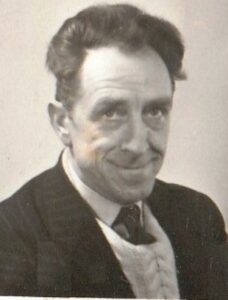
Redmond Friel (1907-1979)
Here is a taster for you: Frolic No. 1 (Deoíndí) for orchestra (1951)
If you enjoyed that you will probably be entranced by the next piece by Friel called “From the Antrim Glens”. It is undated but was broadcast in the late 1970s
I wrote a review of this in 2024:
The opening flourish is like Schubert’s Trout Quintet! I’m sure this was unintentional.
Solo oboe, to a luscious string and harp accompaniment, opens the account with a captivatingly atmospheric folksong melody – unidentified, as such, but presumably a Co. Antrim tune – or maybe even an original Friel melody. The full complement of the strings takes over but we hear again the wistful oboe sliding in at the end of the measure which rounds off with rich horn and harp sounds. An extremely pleasing tableau follows on from this with solo flute to plucked bass and tremolando strings, but then we hear a clarinet to bowed violin strings playing the same theme as the oboe drifts away. This is superb orchestration…
The sublime tune we hear now on unaccompanied clarinet is one that has found fame along the shores of Lough Neagh – “Old Ardboe”. The clarinet is soon joined here by plucked double bass notes and a second clarinet in close harmony, and this is followed by a measure for strings alone swelling up to a full orchestral rendering. However, Friel has yet another gem awaiting us: the full orchestra drops off with some beautiful French horn measures and the clarinet returns with tremolando strings followed by some delicate harp notes and a few little beats from the triangle. A viola sounds the final cadence and then, with a key-change, a fragment of the “Old Ardboe” melody is repeated but with flute deputizing for the clarinet – and a beautifully played flute in this recording…
This is one of the few stereo recordings I ever made of Friel’s music – from a broadcast in the late 1970s. It’s remarkable how much one can actually appreciate a composer’s writing from listening to a stereo recording of it – on headphones, preferably. In the case of this strikingly beautiful work, one can hear the rich separation in the string-writing, the crystal clear timbre of solo instruments and the entire ambience therein. I believe this work to be Redmond Friel’s finest hour. In some ways – in this piece in particular – he is our Marie-Joseph Canteloube (1879-1857), the French composer who made many orchestral settings of French folksongs, most notably his four volumes of Chants d’Auvergne (1923-30) where he uses ravishingly opulent orchestral combinations to showcase the beauty of French traditional song. This is precisely what Friel set out to do in Ireland, from the 1930s onwards, and he captured it in spades in this orchestral tour de force.
Redmond Friel was one of the first Irish Composers to explore the music of Carolan, the great harper composer. Here is Friel’s interpretion of “Morgan Magan” , a tune going back to around 1718. Friel orchestrated it in the early 1960s. It’s a real masterclass in orchestration.
Friel was also a dab hand at choral settings and his catalogue of works lists many original pieces for choir. In 1976, an LP called “In Derry Vale” was released containing 12 arrangements of well-known Irish ballads. Here are two of them. First, his setting of Boolavogue. The choir here is The Foyle Singers conducted by Michael Mason.
By way of contrast, here is the same choir singing an old Co. Armagh song called Casadh Cam na Feadarnaighe arranged by Friel in 1965.
THE CROOKED BEND OF FEDERNAGH During the early 1970s, I was living in South Armagh near the border with Co. Louth. I had just picked up a copy of an old book called “Amhráin Chúige Uladh” which contained many local Gaelic songs. One of those songs was Casadh Cam na Feadarnaí. I very much wanted to visit the site of this notorious “Crooked Bend” on the main road from Culloville to Dundalk. By the 1970s, a so-called concession road had been built (the N53) and the notorious bend had been by-passed. However, I was able to walk up the road and, sure enough, it was a fright even to walk it. Somewhere in this townland (Clonalig) – near this very bend – dwelt the Cailleach Riabhach of the song. Somewhere here, too, dwelt Máire Bean Uí Arbhasaigh and her daughter, both native Irish speakers. Máire was the person who had sung the song for An tAth. Réamonn Ó Muireadhaigh, author of the aforementioned book, in 1934. I tried to sing the song as I walked up the road that day endeavouring to evoke the motley characters that inhabited these strange verses. Some authorities believe the house was either a síbín or a shop.
Weeks later, after I had committed the song to memory, I believe I was the first one to bring it back into circulation. I sang it at many concerts and once or twice on Raidió na Gaeltachta. Before long, others were singing it, including Tríona Ní Dhomhnaill and Mairéad Ní Mhaonaigh. But I never made a commercial recording of it.
Cailleach can mean a hag, a nun, or a wise old woman. There is a suggestion too in some of the verses that the harvest feast, involving the corn dolly or cailleach, is what was actually going on in the house of The Brindled Hag. The district called An Fheadarnach (Federnagh), of which Clonalig is a part, is thought to mean ‘ambush’; but a local elderly man called Barney Campbell told me in 1971, that the name referred to a ‘whispering bush’ that had since disappeared. There is fairy lore hinted at in the song as well (fairies are sometimes called daoine uaisle, noble folk). The bush was at the intersection of the three counties – Armagh, Monaghan and Louth – and may have been a place where an ambush once took place. “Rórán Donn” was a variety of potato in pre-Famine times.
The tune of the song was the same one used in a ballad found in a Herbert Hughes collection of country songs published in 1909. This is A Ballynure Ballad but Casadh Cam na Feadarnaí must surely be considerably older since Máire Bean Uí Arbhasaigh also had the songs of the 18th-century poet, Art Mac Cumhaigh in her repertoire. A Ballynure Ballad belongs to a later English language song tradition that often drew upon old Gaelic airs. The lyrics of the ballad have no relationship with the lyrics of Casadh Cam na Feadarnaí.
And now the beauiful Rannafast song of lost love notated by Redmond himself from the singing of the young Sailí Ní Ghallchóir in 1944 – “Tiocfaidh an Samhradh” This is from a German LP released in 1965 called “Irische Volkslieder”.
Óró! Tiocfaidh an samhradh ‘gus fásfaidh an féar
Agus tiocfaidh an duilliúir glas ar bharr na gcraobh
Tiocfaidh mo ghrá-sa le bánú an lae
Agus buailfidh sí tiún suas le cumha i mo dhiaidh
Scairt mé aréir ag an doras thall
Agus scairt mé aríst an raibh mo rún le fáil.
‘Sé dúirt a dadaí liom nach raibh sí ann
Gur éalaigh sí aréir leis an bhuachaill donn.
Summer at last and the grass grows green
And the leaves grow fast at the top of the trees
My love will come by the morn’s first light
And play sweet music to my heart’s delight
I called last night at yonder door
I called again but my love was no more
Her daddy said that she’d upped and fled
And eloped in the dark with the brown-haired lad
Friel made four settings of Thomas Moore’s National Airs in the 1950s. These are not among the Irish Melodies; they were inspired by European songs from outside Ireland. Nevertheless, we hear in this sample, Friel’s beautiful and engaging piano writing. This is the song When Love is Kind:
When Love Is Kind
by Thomas Moore
When Love is kind,
Cheerful and free,
Love’s sure to find
Welcome from me.
But when Love brings
Heartache or pang,
Tears and such things —
Love may go hang!
If Love can sigh
For one alone,
Well pleased am I
To be that one.
But should I see
Love giv’n to rove
To two or three,
Then — good-bye, Love!
Love must, in short,
Keep fond and true,
Through good report,
And evil too.
Else, here I swear,
Young Love may go,
For aught I care —
To Jericho.
(1819-28)
The Siege of Ennis (mid-1970s) for Orchestra (from a live concert in Dublin)
The Siege of Ennis
I think there is something of the lightness of Tchaikovski’s ballet music here. Such delicate string and wind combinations! Below is an extract from a review I wrote recently:
Two clarinets in perfect harmony punctuate the opening measure – which is a kind of introductory passage – while celli play a charming, bouncy pizzicato underneath. Then the fun begins! Strings play the actual dance measure called “The Siege of Ennis” and this too is punctuated with perky little phrases from the flute until the whole string section launch into a spirited version of the melody lead by the celli. The clarinet takes up the torch while strings enter into a rather busy contrapuntal passage – superb string-writing here! – with plucked bass notes keeping them all steady. This leads to an almost frenzied and syncopated version of the main melody bringing the dance tune safely to harbour.
The oboe, to a slightly heavier pizzicato bass-line this time, continues the fun above some very energetic string writing …plus an oboe d’amour passage underneath (you want this passage to go on forever). Strings then return with flute and piccolo interjections. Full orchestra finishes the section…
I am very grateful to Redmond’s son, Michael Friel, for granting me permission to make his father’s music accessible to the public through this website.
The book “Redmond Friel (1907-1979) – The Composer Revisited” is now available from this website.
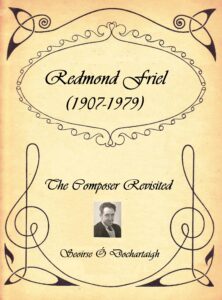
I have here a live recording of the Casadh Cam song as sung at the Oireachtas during the early 1990s. I sing it here with bodhrán maestro, Damien Quinn.
Can you identify this Baroque composer? It’s a Suite for Strings, Flute and Harpsichord
Would you like to know which Baroque composer it is? The clue is in some of the titles.
1. Prelude Maurice O’Connor
2. (a) Allemande Lady Gethin (b) Courante Lady Letitia Burke
3. Sarabande Sí Bheag, Sí Mhór
4. (a) Bourrée I Carolan’s Draught (b) Bourrée II Miss Murphy
5. Gigue Planxty Browne
You were correct! It’s Turlough Carolan (1670-1738). His Italian friends in Dublin called him “Sigr Carrollini”
The genius behind this re-assembling of Carolan’s tunes was none other than world-renowned harpsicordist and composer, John Beckett (1927-2007), first cousin of Samuel Beckett’s. The flautist in the recording is also from the same Dublin family, Edward Beckett.
Is it possible – remembering that Holy Week is just ahead – that an Irish composer would consider using the melody of one of Ireland’s most poignant traditional devotional songs in a string quartet? Well, it happened over 100 years ago when Armagh’s Charles Wood found a local version of Caoineadh na dTrí Muire (The Lamentation of the Three Marys) and wove it into the slow movment of his 6th String Quartet. Here is that movement:
Returning to the music of Carolan, and linking it – geographically – with Charles Wood, it would not be out of place, I think, to provide listeners with four Carolan pieces arranged for harpsichord by Armagh-born Edward Bunting (1773-1843):
Planxty Johnston, Planxty Judge, Planxty Maguire & Planxty Sudley
Dúlamán the Band
It’s seaweed. It’s a song. Yes, we know; Seoirse found it in an old book and passed it on to Clannad who recorded it and generated thousands of performances of it all over the globe.
But what about Dúlamán the Band?
This began as Donegal Folkweave in the early 1990s – Heather Innes from Scotland and myself singing two-part vocal harmonies of Irish and Scottish folksongs to acoustic guitar accompaniment. It was a bit ‘retro’, in a sense, like Robin Hall & Jimmie MacGregor of the folk scene in 1960s Britain. But punters loved it, especially in Scotland.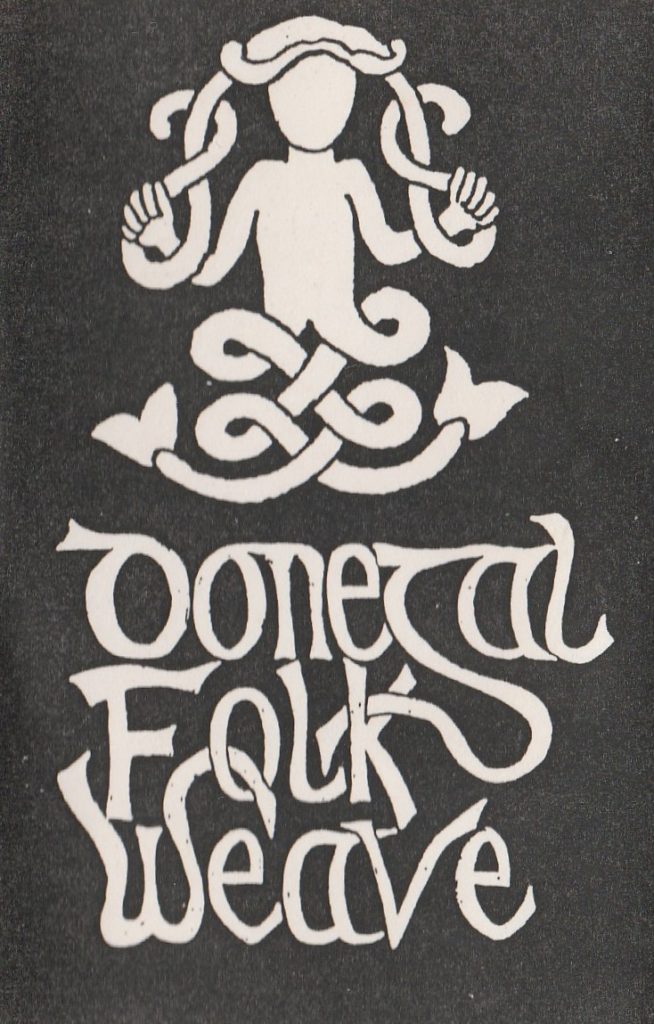
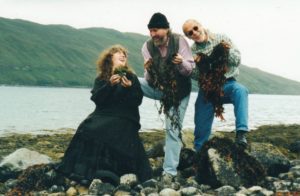
Dúlamán on Skye. The late Alan Ponting (right).
However, it wasn’t until 1995 and a meeting with multi-instrumentalist, Steáfán Hannigan, that we felt we should be looking for a new voice and a new repertoire – a Gaelic repertoire that hadn’t been done much – at least not since the early Clannad stuff of the 70s. The latter had almost abandoned Gaelic music by the 1990s so the coast was clear for a new band – a Gaelic band drawing on my store of songs and stories from the older stratum of indigenous Irish traditions.
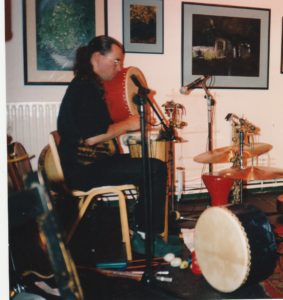
Steáfán Hannigan
So, it went from duo to trio, to quartet, to quintet and, finally, in 1998, a six-piece ensemble populated by myself on lead vocals, spoken voice and guitar; Steáfán Hannigan, percussion, whistles, uilleann pipes; Aodh Mac Ruairí, vocal harmony, guitar, whistles; Heather Innes, vocal harmony; Tony Hunter, percussion; Seán McKay, keyboards.
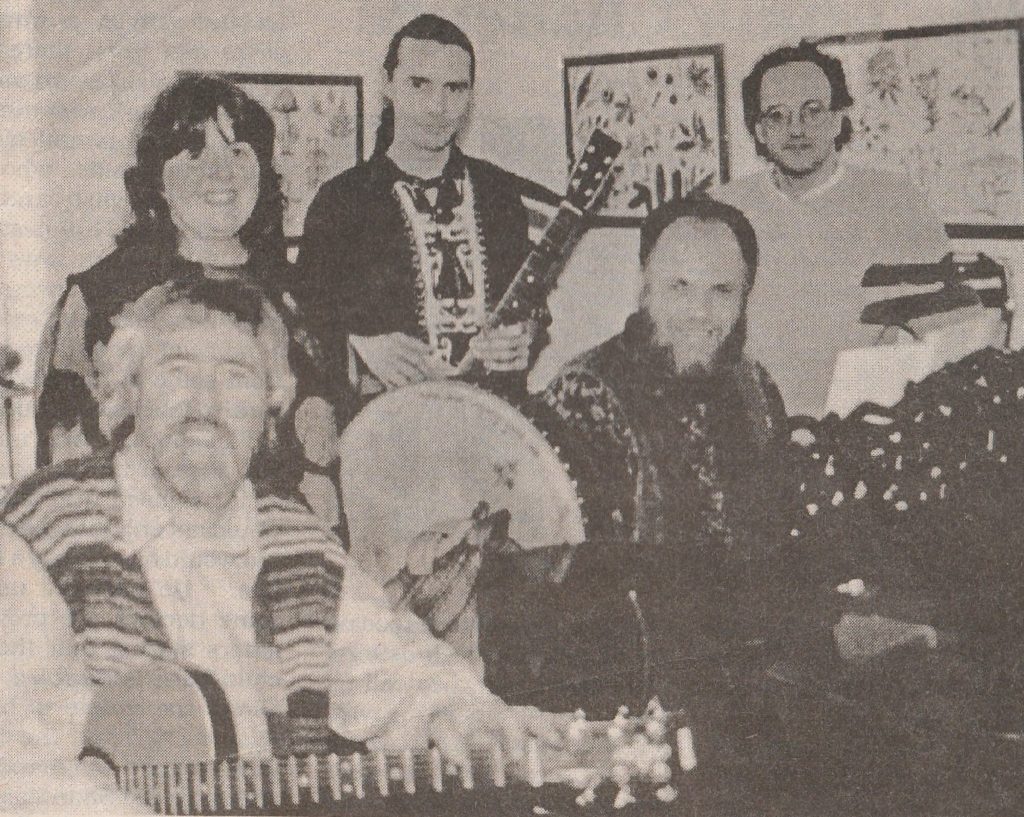
Back (l.-r.): Heather, Aodh, Seán, Tony. Seoirse in front. (Steáfán elsewhere that day).
The band broke up after that – it was simply a matter of lack of running costs and no sign of a CD on the horizon to support the venture . We did start recording in Steáfán’s studio though in Milton Keynes in England but by the time the CDs were issued, Steáfán had left the band and gone with his family to live in Canada. However, we went out with a bang. Our last outing as a full band was in the O’Reilly Hall in UCD 8thDecember 1998. The sound engineers were great friends of ours, Cillian and Colm McEvoy, who presented us afterwards with two cassette tapes recorded in stereo from the sound desk.
So, here it is: the full concert. Please press play and slip on a pair of good headphones.
- Seoladh na nGamhna [Directing the Calves]
- Geaftaí Bhaile Buí [The Gates of the Yellow Town]
- Deoíndí [untranslatable]
- Méiltí Cheann Dubhrann [Sand Dunes of Ranafast]
- An Rábaire [The Dashing Blade]
- Máire Ní Mhaoileoin [Mary Malone]
- Na Gamhna Geala [The White Calves]
- Peigín agus Peadar [ Pegeen and Peter]
- Casadh an tSúgáin [The Twisting of the Rope]
- Bean an Fhir Ruaidh [The Red-haired Man’s Wife] – story & song
- Is Measa Liom Bródach [I Prefer Bródach]
- Tráthnóna Beag Aréir [Late Yesterday Evening]
- Sean-Bhríste Mór [Big Tattered Trousers]
- A Bhean Udaí Thall [O, woman over yonder] – story & song
- Seachrán Chearbhaill [The Ramblings of Carrule]
- Máire Bhéal Átha hAmhnais [Mary from Ballyhaunis]
Dúlamán albums:
Tabhair ar ais an Oíche Aréir Errigal SCD007 (2000)
“Those who go for world music will be enthralled…wonderfully varied…this is a gem of a CD and a pleasure to listen to.” Aiden O’Hara, Irish Music Magazine.
Dúlamán a’ tSléibhe Errigal SCD008 (2002)
“A fairly unique aspect of Dúlamán also is an attempt they have made at story-telling using the accompaniment of chant-like, backing vocals, as opposed to the more traditional solo voice of the seanchaí. This should not be seen as attempt at improving an otherwise perfect art-form in itself, but as a way of bringing song and story closer together, and, perhaps, in the process, making the whole thing a little more listener-friendly… On this album they are joined by too many outstanding musicians to list. The result is a richly layered recording of traditional songs, given a contemporary, polished presentation. However the presentation is not just a gloss. Dúlamán a’ tSléibhe is a triumph of both content and style!” Aidan Crossey, Pay The Reckoning.
The above clip is taken from a documentary called “Roots of a Man” (2005) made by young Toronto film-makers Matthew & Jeffery Campagna whose Inishowen ancestry (Ó Dochartaigh) led them to the peninsula in search of the their roots. Seoirse accompanied them during the making of it. He is sitting here in the dungeon of Castle Ross on Inch, one of the remaining Ó Dochartaigh strongholds, perched dramatically on a cliff on the southern shores of the island. The full story of their journey is available at www.rootsof a man.com
This clip was filmed in the Gaeltacht of Teileann in south Donegal as part of a special feature on “Ardán” on TG4 in 1998.